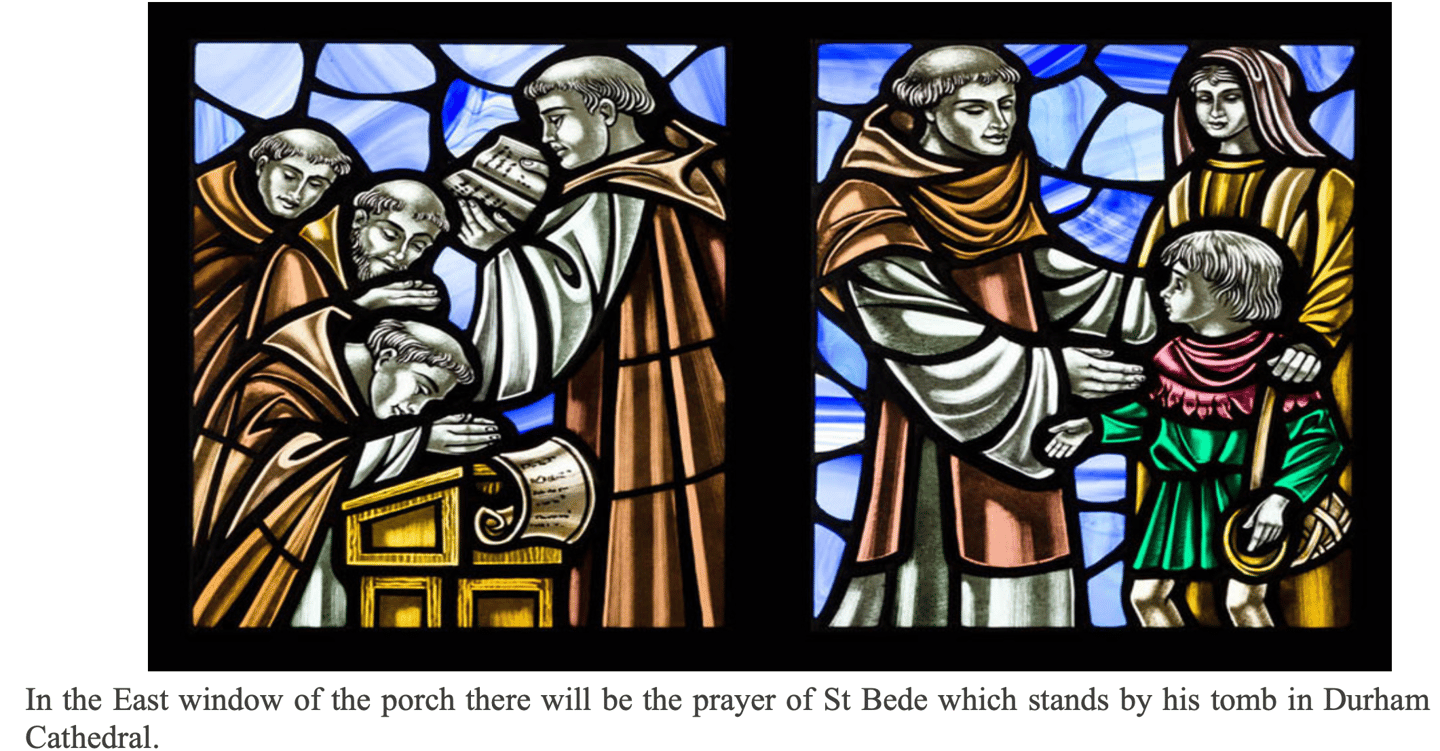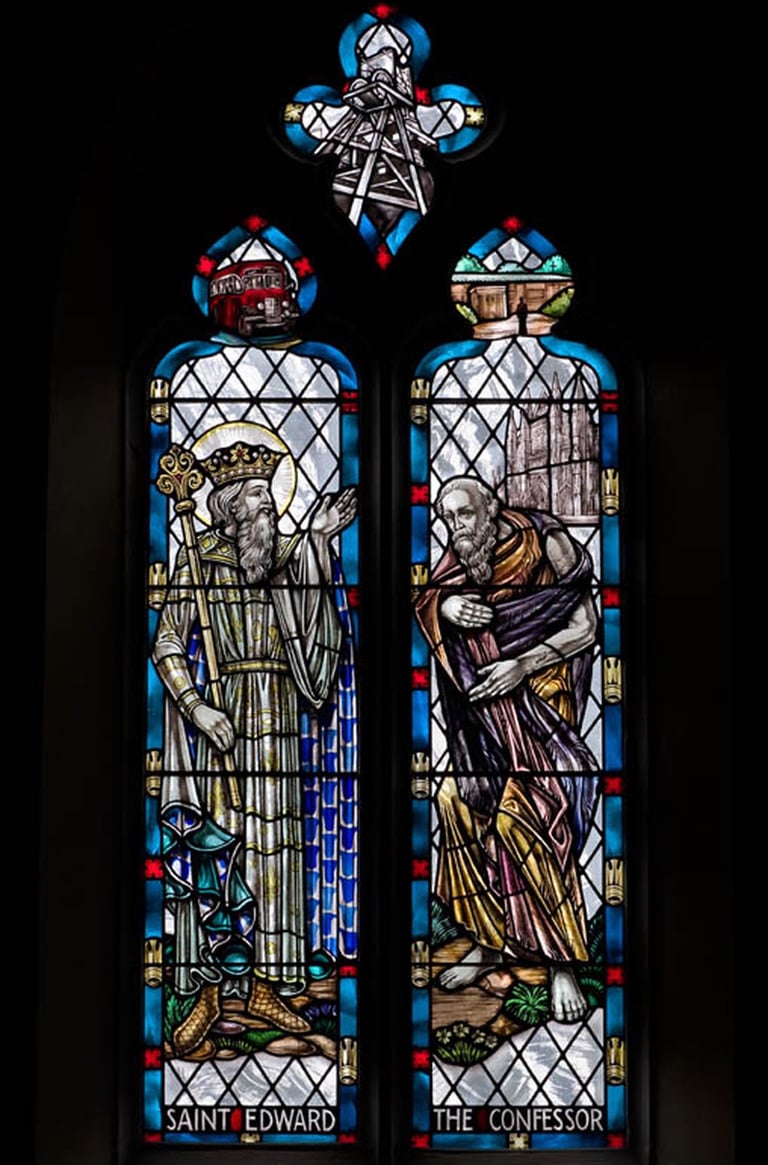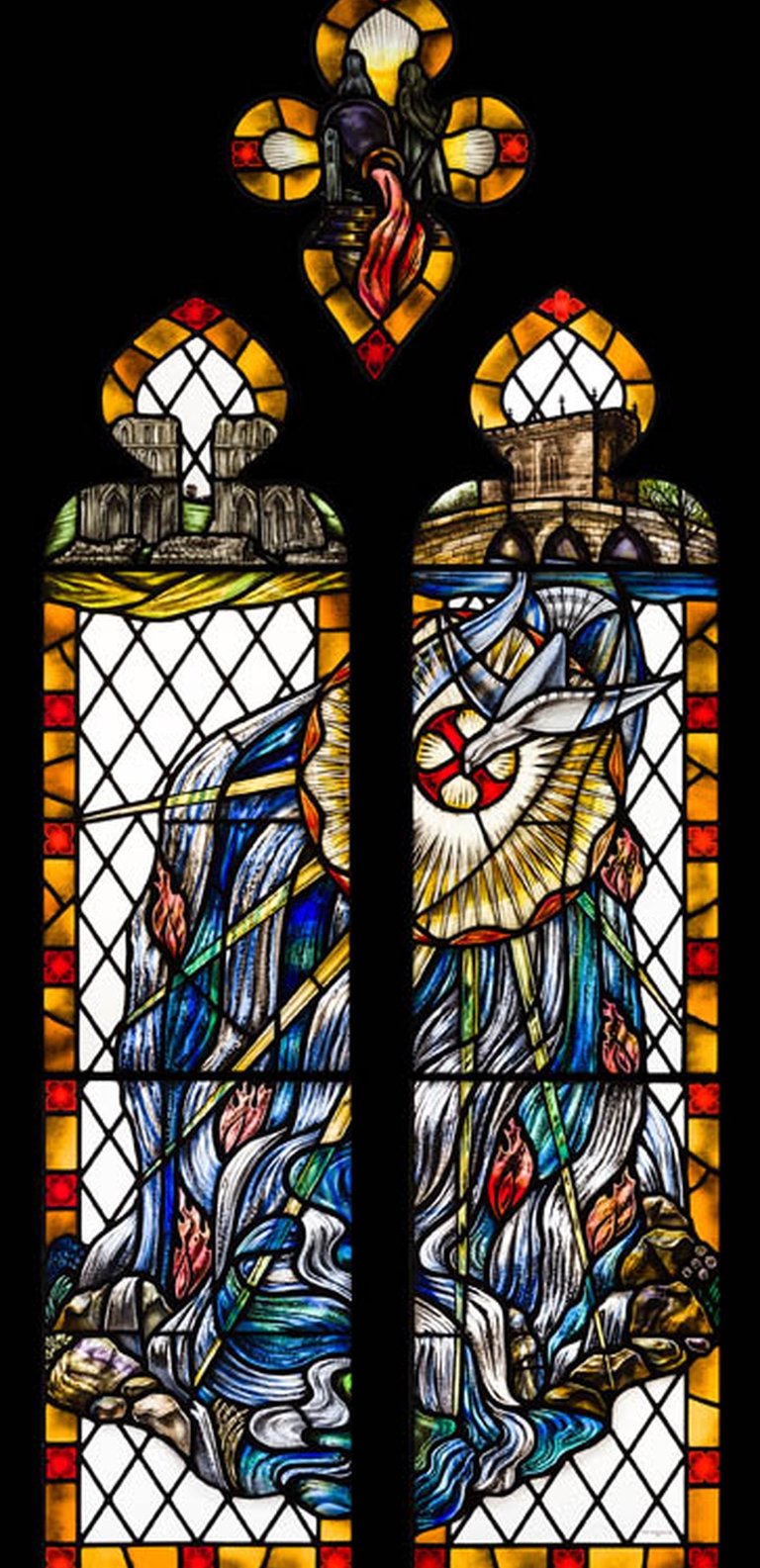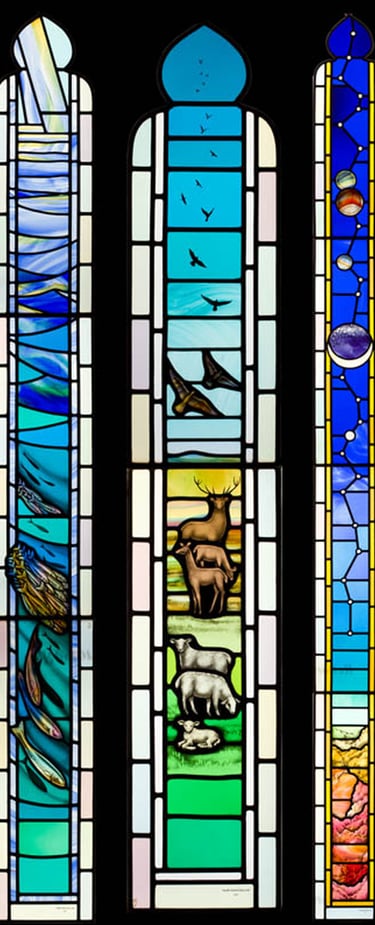Tour The Church
The Outside
The graveyard on the right as you face the church from St Bede's Road dates from soon after the church was built in 1842. It is now virtually full. There are no more plots to be bought, though some graves may still have space in them. In 2007 an ancient wall to the left of the building was partially knocked down and its repair necessitated the demolition of a block of three garages. A new garage was built to the left of the church and this gave the opportunity for developing an extension to the graveyard. Plots can be requested, but are limited to those who are parishioners of St Bede's (See “Policy for burial in the New Graveyard”.).
The Porch
Entering the church through the main doors, look to the right. The windows depict a tree of life which asks for prays for the priests and people of the churches founded from St Bede's or which have become St Bede's responsibility (St Edward the Confessor, Brinsworth and its mass centre, St John Fisher, Tinsley).
Below the 'Tree of Life' is a mural showing a copy of William Holman Hunt's picture “Christ, the Light of the World” ( ) which was made by Douglas Watson (...) in 2010. Surrounding it and on the adjacent wall are memorial tiles. On either side of the statue of St Jospeh (Patron of a happy death) there is a memorial to those from the parish who died in the two world wars.
On the north wall are four square stained glass windows depicting incidents in the life of St Bede (673-735). Reading from right to left: Bede is taken to the monastery at Wearmouth as a boy of seven; he chooses the life of a monk at Jarrow; he is the great teacher, Scripture scholar and historian; and the account of his death, written by Cuthbert, was known across Europe.


The Stained Glass
The Stained Glass in the Body of the Church On the right hand side as you enter the Church is a single light depicting St John Fisher (1469-1535). The windows on this side commemorate the parishes for which St Bede's has assumed responsibility in recent years. St John Fisher was the dedication for the mass centre in Tinsley of the parish of St Edward the Confessor in Brinsworth. The glass shows the saint who was Bishop of Rochester, the poorest diocese in the land and one which he would not leave. He was created Cardinal by Pope Paul III but never received the cardinal's red hat which thus lies at his feet. Henry VIII found an implacable opponent to his plans to divorce Catherine of Aragon in the bishop and had him tried and executed for treason. The model for the image is taken from a window in St Marie's Cathedral which is depicted in the background. The links between St Bede's and St Marie's go back to the founder of St Marie's Fr Charles Pratt who died before St Marie's was completed in 1850 and was buried in the graveyard here. When the Sheffield church was nearly completed his body was dug up and re-buried in the sanctuary area of his church, where he has a memorial. The present parish priest of St Bede's was an assistant in St Marie's (1983-85) and Rector there (1985-1994).
Also shown at the top of the window is the Tinsley Viaduct which carries the M1 motorway; and the cooling towers which were for many years were a landmark for travellers. They were demolished in 2008.
The next window on the right was introduced in memory of the priests and parishioners of St Edward the Confessor, Brinsworth which was opened in 1968 by Fr (later Monsignor) Stephen Sullivan – another assistant priest and Rector of St Marie's and closed in 2005. The window shows the saintly king (1003 - 1066) who was said to have 'the king's touch' – the ability to cure scrofula. He is shown healing a poor man, who might be his brother in terms of physical likeness. What separates king from pauper? In the background is Westminster Abbey, founded by Edward and the place of his tomb and shrine. Above the figures is a minehead, this region was established through coal and steel; and the parish church, a Nissan hut; and the omnibus, “Us Bus” which collected people for mass and bingo in the early days of what was then a vibrant parish.




The third window depicts the Forty Martyrs' of England and Wales, the dedication of the Catholic Church in Kimberworth Park, (founded 1971) since 2006 a mass centre served from St Bede's. At the forefront are Edmund Campion (1540-1581), the Jesuit scholar and Margaret Clitherow (c1556-1586) wife and mother of York. The ranks of martyrs are behind them and a scaffold, their place of sacrifice stands over them. Kepple's Column, a landmark in the area, formally part of the Fitzwilliam estate, locates the church.
These windows were introduced between 2007 and 2009. Above the High Altar the stained glass is much older but its date is unknown. St Bede is depicted between the Bishops Patrick and Paulinus, each is wearing a pallium – a scarf that goes over the shoulders and hangs down the front; made of lamb's wool, it is given by the Pope to an Archbishop as a sign of unity. Bede holds a scroll saying “St Bede, ora pro nobis” – pray for us.
If you move towards the baptistery on the left hand side of the church at the back, you can view the three windows which reflect the history of this building.
Nearest the baptistery God the Father, fons et origo, fount and creator of all things, is depicted in the act of creating. A mighty swirl brings the waters of the great rivers into being, and we can see planets and animals, and human kind and serpent. The predominant colour is green as this window remembers the Irish who built the church. They came to tunnel, among other works, and the Woodhead Tunnel is depicted at the top of the window and the tunnellers themselves are seen below it.
The second window shows God the Son, Prince of peace. The original chapel was extended to include the porch and organ loft as a memorial to those from the parish who died in the first world war. Christ is shown as King (the crown and sceptre); Priest (he wears a above his alb, a dalmatic – the vestment of a deacon; a chasuble, the robe of a priest; and a pallium, a symbol of an Archbishop, thus he represents the three orders of priesthood in his dress); and he is a prophet he fulfils Isaiah's prophecy of swords being turned into ploughshares (Is 2,4b). These are the three roles in which we share through baptism (“As Christ was anointed priest, prophet and king so may you live as a a member of his body sharing everlasting life”- the prayer at the anointing with chrism after baptism). The heavenly city, the new Jerusalem is seen coming from heaven (Apoc. 21,2) amid fire and devastation. Soldiers can be seen fighting from the trenches. Above, the memorial at..... commemorating those who have no memorial, designed by Edwin Lutyens, is shown.
The third window depicts the Holy Spirit and invites reflection on Catholic Rotherham. The Bessamer Converter is shown above the Chapel on the Bridge and Roche Abbey. Below the Spirit in the form of a dove (Mk 1,10) descends amid a flow of water (reminds us of the creation of the God the Father window) and in the swirl of waters are seven flames, bringing to mind both Pentecost (Acts 2, 3) and the gifts of the Holy Spirit(cf 1 Cor 12).
Over the organ is another ancient stained glass window which has a recusant history. The story was researched by Rev Deacon Bill Burleigh.
Some time after the second world war, Cecil Higgins, a window restorer who had put back the windows in St Marie's received a call from Fr Hammond the parish priest of St Bede's. Could he repair a large bulging window in the church that was in such a bad state that it let in water and draughts? The window was plain red and clear diamond shaped glass pieces with rooted lead and many cracked and broken panes. Not worth repairing at all. Only fit for scrap.
At the same time Cecil's company had a call from a solicitor seeking a glass expert to remove an unwanted window from a large country house. The new owner, a retired military officer, wanted to turn the former chapel of the house into a billiard room. The stained glass window of the chapel, he said, upset him.
On seeing the chapel window, Cecil immediately realised that the old family house must have belonged to Catholics. The stained glass was a full length representation of Our lady. Quick thinking and opportune timing meant that the billiard room loss could become St Bede's gain. So Cecil took the stained glass back to his company.
The finance director was all for smashing up the old window as there was no obvious use for it. But Cecil hot-footed over to Rotherham armed with a drawing he's made showing how he would insert the stained glass figure of Mary into a new window for St Bede's, retaining the diamond shaped surrounding glass.
Fr Hammond was impressed and bought the replacement window to go in the West end (liturgically, north end actually). But not before checking thoroughly that the old window had not fallen off the back of a lorry.
What neither Cecil nor Fr Hammond realised was that their replacement window was steeped in local Catholic history. The old family house was none other than Revell Grange at Stannington. The Revell family chapel had been a Mass centre from 1742 until 1828 where priests had quietly ministered to the Catholic community for miles around.Mass was again celebrated there from 1855 right through to 1929.
The window shows our Blessed Lady attended by six angels. She is dressed in a white robe decorated with gold fleur-de-lys. Her arms are across her chest in a receptive pose as the Holy Spirit, in the form of a dove, overshadows her with golden rays. She stands on the moon (cf Rev. 12,1) and stars shine above clouds.There is a saint on either side of Mary, each is accompanied by an angel. Their identities are unclear. On the left is a priest bearing a crucifix. He may be St John of the Cross (1500- 1569), the Spanish mystic, though above him is the Greek – his which in Latin lettering becomes JES, an abbreviation for the Holy Name, associated with the Jesuits, the Society of Jesus and thus the saint could be St Ignatius Loyola, the founder of the society. On the right is a Carmelite nun who may be St Theresa of Avila (1515-1582), another Spanish mystic like John of the Cross. Theresa reformed the Carmelite Order, founded the discalced (un-shod) congregation – but this saint is wearing sandals! John of the Cross is also known s St John of Avila and he and Theresa corresponded, which offers an explanation of their presence. Corresponding to the his above the male saint there is XPS above the female religious. Again it is Greek lettering which in Latin script becomes Chrs, an abbreviation for Christ.
The Stained Glass in the Sanctuary -
The Stained Glass over the High Altar -
At the top of the window The Annunciation is shown. Below on the left the Magi bring their gifts to, on the right, Mary holding the infant Jesus.
In the main lights, St Bede is in the centre, holding a scroll giving his name and and title: “Ven Bede Presb.” - Venerable Bede Priest, below him is the prayer “Ora pro nobis” - Pray for us. On the left is St Patrick (c390 - c461) and on the right St Paulinus of York(d. 644). Both are wearing priestly vestments, a chasuble above an alb, and a pallium, the woollen scarf-like band with a hanging strip back and front, marked with five black crosses. that the Pope gives to every Archbishop as a sign of the unity of the Church. Both are in red vestments though neither was a martyr. Bede is in a blue cassock. Red blue and green are the predominant colours in the window.
The Stained Glass in the side windows -
The side windows are a meditation of Psalm 8:
How great is your name O Lord our God, through all the earth.
Your majesty is praised above the heavens
On the lips of children and of babes
You have found praise to foil your enemy,
To silence the foe and the rebel.
When I see the heavens the work of your hands,
The moon and the stars that you arranged,
What is man that you should keep him in mind,
mortal man that you cared for him?
Yet you have made him little less than a god;
With glory and power you crowned him,
You gave him power over the work of your hand,
Put all things under his feet.
All of them sheep and cattle,
Yes, even the savage beasts
,birds of the air and fish,
That make their way through the waters.
How great is your name, O Lord our God, through all the earth.
They link across the Church with the Our Father window which shows the creative power of God and Adam and Eve; and human creativity in the work of the tunnellers.




The Sanctuary
The crucifix that hangs above the chancel reminds the visitor of the Rood Screen that originally separated the nave from the sanctuary. The present crucifix is a recent import to the church. The previous one which hung in the same position fell just before Mass on a Summer's day in 2009, giving the parish priest who was sitting in the front pew a nasty shock. The cross had been suspended with a single chain and small hooks. The present crucifix came from the church of the recently closed parish of Our Lady of Grace, Kinsey, West Yorkshire, where Fr Bill Burtoft had been parish priest before his retirement. The crucifix was donated by Margaret Whitemore in memory of her grand daughter who was delighted that it had found a new home. The mosaic work was inlaid by the late Ron Howie, a parishioner at Kinsey.The altar was installed in 1959. In 2007 Paul Lupton of Lupton Marble and Granite was commissioned to introduce an ambo that matched the marble of the sanctuary. The design was agreed between himself and the parish priest, and provides a fittingly noble place for the proclamation of the Word of God.
On the left of the sanctuary is a square opening which gave a view of the High Altar (before the altar was moved forward for the Missa Normativa). It is known as a squint or, more formally a hagioscope – giving a view of the Holy.
The Mary-Altar
This altar was installed in the late 1950's on the occasion of the silver jubilee of ordination of the parish priest, Fr Daly. The icon on the right is Our Lady of Chestohova (The Black Madonna). The picture was donated by a member of the Polish community who have worshipped regularly at St Bede's since the end of the second world war.
The Baptistery
The font is mentioned in the account of the opening of the church, quoted in the History of St Bede's on this website. It was repositioned here when the extensions were completed in the 1930's. The area was renovated in the 1990s with a donation from the Hargan family. The two Doctors Hargan worked for many years in general practise in Rotherham and are buried in the old graveyard. The striking crucifix just outside the baptistery was given to Bishop Gerald Moverley, the first Bishop of Hallam, by the artist (name unknown) after a visit to Peru. For the stained glass, water streams of water issue from a shell, the symbol of baptism. The water descends to three fishes, symbolizing the Holy Trinity. Continuing the water theme the bulrush, a symbol of salvation, appears at the base. Centre Light - This light features the sun, a symbol of Jesus Christ (Malachi 4:2). The source of light , heat and energy the sun represents spiritual illumination and glorification. Stars and rays issue from the sun and at the base candles burn, symbolising Jesus Christ as the Light of the World. This light shows a family, with a mother holding her new born baby, bringing the child to be baptised, surrounded by other members of the family. At the base, balancing the bulrushes in the left light, are lilies for purity and innocence. The colours have been chosen to maintain good natural light in the Baptistery. The cheerful colours of the pictorial elements are set against a background of handmade clear and tinted glass containing textures and ripples to bring interest and sparkleas with the West elevation, the colours have been chosen to maintain good natural light. The strongest colours are confined to the pictorial elements while a variety of handmade clear and pale blue tinted glasses, containing textures and ripples, are used as a backdrop.
The Parish Rooms
Returning to the Lady Altar, there is a small door on the left which leads a corridor where the sacristy/vestry is located. There are two noteworthy paintings here. At the tops of the steps, a young girl's portrait by the Stellenbosch artist Maryna de Witt; and above the steps “African Madonna II” by the South African Lesley Penn. Down the steps is the presbytery, built in 1937 by the architects Fox and Hill of Union Street, Dewsbury. The house was designed for three/four priests, a housekeeper and a maid. Times change and for several decades there has been a sole resident. In 2004 the house was extensively remodelled to allow meetings and social activity on the ground floor. The parish priest lives in the rooms above.
There are refreshments after Sunday morning mass and other activities - see the weekly newsletter.


